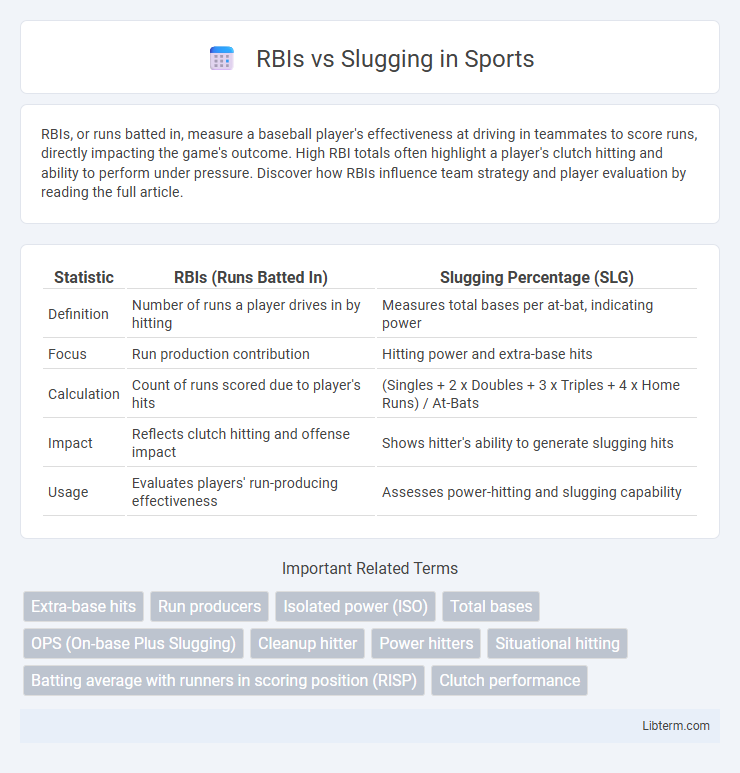RBIs, or runs batted in, measure a baseball player's effectiveness at driving in teammates to score runs, directly impacting the game's outcome. High RBI totals often highlight a player's clutch hitting and ability to perform under pressure. Discover how RBIs influence team strategy and player evaluation by reading the full article.
Table of Comparison
| Statistic | RBIs (Runs Batted In) | Slugging Percentage (SLG) |
|---|---|---|
| Definition | Number of runs a player drives in by hitting | Measures total bases per at-bat, indicating power |
| Focus | Run production contribution | Hitting power and extra-base hits |
| Calculation | Count of runs scored due to player's hits | (Singles + 2 x Doubles + 3 x Triples + 4 x Home Runs) / At-Bats |
| Impact | Reflects clutch hitting and offense impact | Shows hitter's ability to generate slugging hits |
| Usage | Evaluates players' run-producing effectiveness | Assesses power-hitting and slugging capability |
Understanding RBIs and Slugging: Key Baseball Metrics
RBIs (Runs Batted In) measure a player's ability to drive teammates home, directly reflecting offensive productivity and clutch hitting in baseball. Slugging percentage quantifies the total bases a player earns per at-bat, emphasizing power hitting through extra-base hits like doubles, triples, and home runs. Understanding RBIs and slugging together provides a comprehensive view of a player's overall offensive impact, combining run production and hitting power metrics.
The Definition and Calculation of RBIs
RBIs, or Runs Batted In, represent the total number of runs a player generates by successfully hitting the ball, excluding runs scored due to errors or double plays. The calculation of RBIs involves crediting a batter each time a run scores as a direct result of their at-bat, including hits, sacrifice flies, and bases-loaded walks. Slugging percentage, by contrast, measures a player's power-hitting ability by calculating total bases divided by at-bats, emphasizing the quality of hits rather than the resulting runs.
What Is Slugging Percentage?
Slugging percentage is a key baseball statistic that measures a hitter's power by calculating the total bases achieved per at-bat. Unlike RBIs, which indicate a player's ability to drive in runs, slugging percentage focuses on the quality and impact of hits, including singles, doubles, triples, and home runs. A higher slugging percentage reflects greater offensive productivity and slugging ability, making it essential for evaluating a player's slugging effectiveness.
Comparing the Importance: RBIs vs Slugging
RBIs (Runs Batted In) measure a player's ability to drive teammates home and directly contribute to scoring, serving as a critical indicator of clutch hitting and situational effectiveness. Slugging percentage (SLG) quantifies a hitter's power by calculating total bases per at-bat, highlighting the player's ability to produce extra-base hits like doubles, triples, and home runs. While RBIs showcase run production impact, slugging percentage offers a more comprehensive assessment of offensive power and consistency, making both metrics essential but distinct for evaluating overall batting performance.
Offensive Value: How RBIs and Slugging Reflect Performance
RBIs (Runs Batted In) directly measure a player's ability to contribute to team scoring by driving in runs, highlighting clutch offensive performance. Slugging percentage quantifies a hitter's power by accounting for total bases per at-bat, reflecting overall extra-base hit impact. Together, RBIs and slugging percentage provide a comprehensive evaluation of a player's offensive value, balancing run production and power hitting.
Contextual Factors: Lineup Position and Opportunity
RBIs depend heavily on lineup position because middle-order hitters often have more opportunities with runners on base compared to leadoff batters who primarily focus on reaching base. Slugging percentage measures raw power and reflects a player's ability to produce extra-base hits regardless of batting order context. Team dynamics, such as the on-base skills of preceding hitters, significantly influence RBI opportunities, making RBIs a less stable metric for individual power assessment than slugging.
Historical Leaders in RBIs and Slugging
Hank Aaron leads in career RBIs with 2,297, showcasing unmatched run-producing consistency, while Babe Ruth dominates slugging percentage at .690, highlighting his power-hitting prowess. Alex Rodriguez ranks third in RBIs with 2,086 and maintains a career slugging percentage of .550, balancing contact and power. These legends exemplify the impact of run batted in totals and slugging as key metrics for evaluating offensive dominance in baseball history.
Situational Hitting: When RBIs Matter Most
RBIs (Runs Batted In) are crucial in situational hitting, highlighting a player's ability to deliver under pressure by driving in teammates when scoring opportunities arise, particularly with runners in scoring position. Slugging percentage measures overall power hitting regardless of game context, whereas RBIs emphasize clutch performance that directly impacts the scoreboard during critical moments. Understanding the difference helps teams value hitters who excel at converting scoring chances into runs, maximizing offensive efficiency during high-leverage situations.
Power Hitters and Slugging Dominance
Power hitters excel in generating high slugging percentages by consistently delivering extra-base hits such as doubles, triples, and home runs, which directly contribute to their slugging dominance. While RBIs measure the ability to drive in runs, slugging percentage more accurately reflects a player's raw power and impact at the plate. Leading MLB power hitters often combine high RBI totals with elite slugging percentages, underscoring their role as offensive force multipliers in run production and slugging dominance.
Which Stat Should Matter More in Player Evaluation?
RBIs measure a player's ability to drive in runs and contribute directly to the team's score, reflecting clutch hitting and situational performance. Slugging percentage evaluates a player's power-hitting capability by accounting for total bases per at-bat, highlighting their ability to produce extra-base hits and generate offensive momentum. In player evaluation, slugging percentage often provides a more comprehensive indicator of offensive value, as it captures both consistency and power, while RBIs depend heavily on teammates' ability to get on base.
RBIs Infographic

 libterm.com
libterm.com